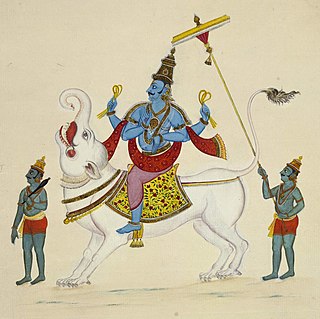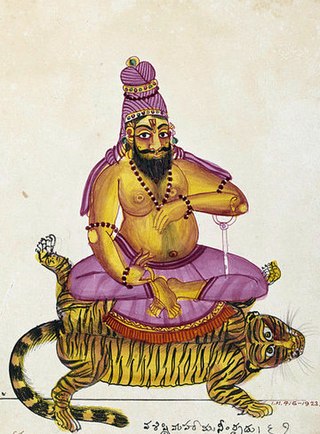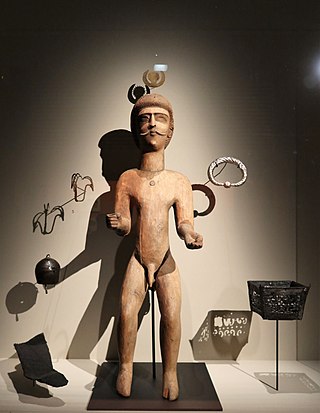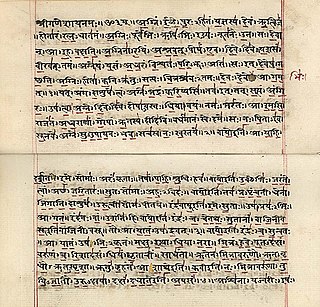Varuna is a Hindu god. Varuna may also refer to:
Contents
- Mitra–Varuna, dual Hindu deities, incorporating Mitra and Varuna
- Mitra-Varuna (Indo-European), deities in Proto Indo-European religion
Varuna is a Hindu god. Varuna may also refer to:

Varuna is a Hindu god, associated with the oceans and water. In the Vedic scriptures, he is paired with the god Mitra and is the lord of Ṛta (justice) and Satya (truth). Varuna is also mentioned as an Aditya, the sons of the goddess Aditi.

Indra is the king of the gods, devas (deities) and Svarga (heaven) in Hinduism. He is associated with the sky, lightning, weather, thunder, storms, rains, river flows, and war. Indra's powers are similar to other Indo-European deities such as Jupiter, Perun, Perkūnas, Zalmoxis, Taranis, Zeus, and Thor, part of the greater Proto-Indo-European mythology.

Aditi is an important Vedic goddess in Hinduism.
In the Vedic religion, Ṛta is the principle of natural order which regulates and coordinates the operation of the universe and everything within it. In the hymns of the Vedas, Ṛta is described as that which is ultimately responsible for the proper functioning of the natural, moral and sacrificial orders. Conceptually, it is closely allied to the injunctions and ordinances thought to uphold it, collectively referred to as Dharma, and the action of the individual in relation to those ordinances, referred to as Karma – two terms which eventually eclipsed Ṛta in importance as signifying natural, religious and moral order in later Hinduism. Sanskrit scholar Maurice Bloomfield referred to Ṛta as "one of the most important religious conceptions of the Rigveda, going on to note that, "from the point of view of the history of religious ideas we may, in fact we must, begin the history of Hindu religion at least with the history of this conception".

The historical Vedic religion constituted the religious ideas and practices prevalent amongst the Indo-Aryan peoples of the northwest Indian subcontinent during the Vedic period. These ideas and practices are found in the Vedic texts, and some Vedic rituals are still practiced today. It is one of the major traditions which shaped Hinduism, though present-day Hinduism is significantly different from the historical Vedic religion.

Deva means "shiny", "exalted", "heavenly being", "divine being", "anything of excellence", and is also one of the Sanskrit terms used to indicate a deity in Hinduism. Deva is a masculine term; the feminine equivalent is Devi. The word is a cognate with Latin deus ("god") and Greek Zeus.
Aryaman is one of the early Vedic Hindu deities. His name signifies "Life-Partner", "close friend", "Partner", "play-fellow" or "companion". He is the third son of Kashyapa and Aditi, the father and mother of the adityas, and is depicted as the mid-morning sun disc. He is the deity of customs, and rules over the customs that rule the various Vedic tribes and people.
Samudra is a Sanskrit term literally meaning the "gathering together of waters". It refers to an ocean, sea or confluence. It also forms the name of Samudradeva, the Hindu god of the ocean. The word is also present on other languages influenced by Sanskrit.
Mitra and Varuna are two deities frequently referred to in the ancient Indian scripture of the Rigveda. They are both considered Ādityas, or deities connected with the Sun; and they are protectors of the righteous order of rita. Their connection is so close that they are frequently linked in the dvandva compound Mitra–Varuna.

Vasishtha is one of the oldest and most revered Vedic rishis or sages, and one of the Saptarishis. Vasishtha is credited as the chief author of Mandala 7 of the Rigveda. Vasishtha and his family are mentioned in Rigvedic verse 10.167.4, other Rigvedic mandalas and in many Vedic texts. His ideas have been influential and he was called the first sage of the Vedanta school of Hindu philosophy by Adi Shankara.
Rigvedic deities are deities mentioned in the sacred texts of Rigveda, the principal text of the historical Vedic religion of the Vedic period.

Mitra is a Hindu god and generally one of the Adityas, though his role has changed over time. In the Mitanni inscription, Mitra is invoked as one of the protectors of treaties. In the Rigveda, Mitra appears primarily in the dvandva compound Mitra-Varuna, which has essentially the same attributes as the god Varuna alone, e.g. as the principal guardian of ṛtá "Truth, Order". In the late Vedic texts and the Brahmanas, Mitra is increasingly associated with the light of dawn and the morning sun. In the post-Vedic texts – in which Mitra practically disappears – Mitra evolved into the patron divinity of friendship, and because he is "friend", abhors all violence, even when sacred.
Mitra is an Indo-Iranian deity.

The annually held Varuna naval exercise is an integral part of France–India strategic relationship in the 21st century and consists of naval cooperation drills between the French Navy and the Indian Navy. The joint-exercises are held either in the Indian Ocean or Mediterranean Sea with the aim of improving Indo-French coordination on capabilities like cross-deck operations, replenishment-at-sea, minesweeping, anti-submarine warfare and information sharing. It was first started in 1983, though given its present name in 2001. France is Littoral State of the Indian Ocean through the French Overseas region of Réunion, Mayotte and Scattered Islands in the Indian Ocean.
Dutta, also spelled Datta, is an Indian family name Its variation is Dutt.

In Hinduism, Adityas, refers to the offspring of Aditi, the goddess representing the infinity. The name Aditya, in the singular, is taken to refer to the sun god Surya. Generally, Adityas are twelve in number and consists of Vivasvan, Aryaman, Tvashta, Savitr, Bhaga, Dhata, Mitra, Varuna, Amsa, Pushan, Indra and Vishnu.

In Hindu Epic, there are deities or heroes whose attributes or behavior can be interpreted as lesbian, gay, bisexual, or transgender (LGBT) or have elements of gender variance and non-heterosexual sexuality. Traditional Hindu literary sources do not speak of homosexuality directly, but changes of sex, homoerotic encounters, and intersex or third gender characters are often found both in traditional religious narratives such as the Vedas, Mahabharata, Ramayana and Puranas as well as in regional folklore.
Cadex 2009 was a military training exercise involving the Indian Navy, Sri Lanka Navy and the Indian Coast Guard. The three-day-long training exercise was held from 6 October to 8 October 2009. Training exercises between the two countries had been held annually, but this had been delayed because of the Sri Lankan Civil War. It was also the first training exercise between the two navies since the end of the war.

The Rigveda or Rig Veda is an ancient Indian collection of Vedic Sanskrit hymns (sūktas). It is one of the four sacred canonical Hindu texts (śruti) known as the Vedas. Only one Shakha of the many survive today, namely the Śakalya Shakha. Much of the contents contained in the remaining Shakhas are now lost or are not available in the public forum. Rigveda Samhita was composed in the northwestern region of the Indian subcontinent

Mitra-Varuna is a proposed deity or dyad of deities suggested to have existed in Proto-Indo-European religion and mythology. First proposed by Georges Dumézil, he considered it to have been composed of two distinct elements – Mitra and Varuna – this divine pair represented different aspects of sovereignty, with Mitra embodying reason, order, and benevolence, and Varuna symbolizing violence, darkness, and inspiration.